Nurses' Views on CPR for End of Life Patients
VerifiedAdded on 2023/01/09
|18
|4769
|48
AI Summary
This literature review examines nurses' perceptions and challenges surrounding cardiopulmonary resuscitation (CPR) for end of life patients. It explores the ethical dilemma and decision-making process faced by nurses. The review also highlights the need for proper competencies and skills in performing CPR, as well as the importance of patient involvement in DNACPR decisions.
Contribute Materials
Your contribution can guide someone’s learning journey. Share your
documents today.
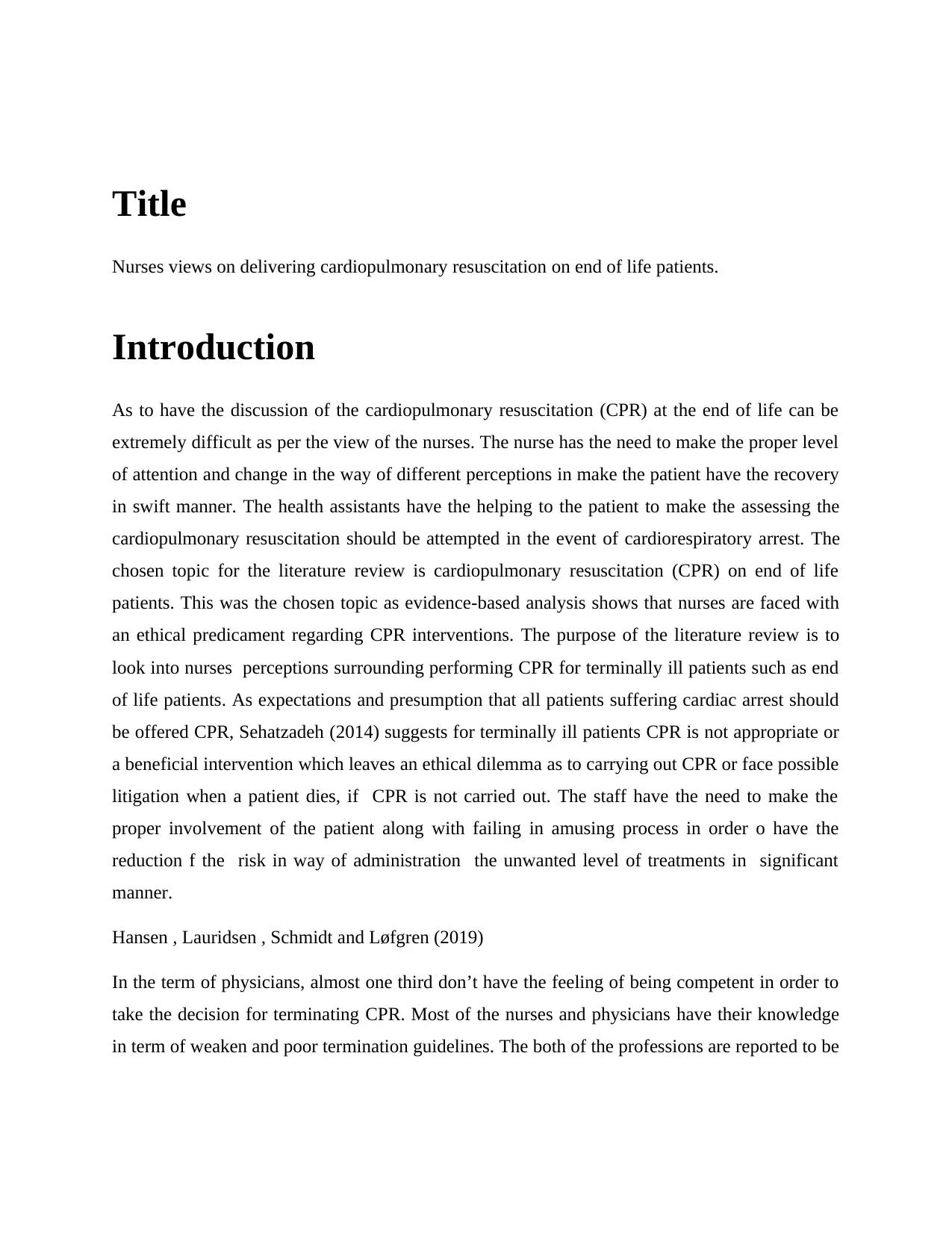
Title
Nurses views on delivering cardiopulmonary resuscitation on end of life patients.
Introduction
As to have the discussion of the cardiopulmonary resuscitation (CPR) at the end of life can be
extremely difficult as per the view of the nurses. The nurse has the need to make the proper level
of attention and change in the way of different perceptions in make the patient have the recovery
in swift manner. The health assistants have the helping to the patient to make the assessing the
cardiopulmonary resuscitation should be attempted in the event of cardiorespiratory arrest. The
chosen topic for the literature review is cardiopulmonary resuscitation (CPR) on end of life
patients. This was the chosen topic as evidence-based analysis shows that nurses are faced with
an ethical predicament regarding CPR interventions. The purpose of the literature review is to
look into nurses perceptions surrounding performing CPR for terminally ill patients such as end
of life patients. As expectations and presumption that all patients suffering cardiac arrest should
be offered CPR, Sehatzadeh (2014) suggests for terminally ill patients CPR is not appropriate or
a beneficial intervention which leaves an ethical dilemma as to carrying out CPR or face possible
litigation when a patient dies, if CPR is not carried out. The staff have the need to make the
proper involvement of the patient along with failing in amusing process in order o have the
reduction f the risk in way of administration the unwanted level of treatments in significant
manner.
Hansen , Lauridsen , Schmidt and Løfgren (2019)
In the term of physicians, almost one third don’t have the feeling of being competent in order to
take the decision for terminating CPR. Most of the nurses and physicians have their knowledge
in term of weaken and poor termination guidelines. The both of the professions are reported to be
Nurses views on delivering cardiopulmonary resuscitation on end of life patients.
Introduction
As to have the discussion of the cardiopulmonary resuscitation (CPR) at the end of life can be
extremely difficult as per the view of the nurses. The nurse has the need to make the proper level
of attention and change in the way of different perceptions in make the patient have the recovery
in swift manner. The health assistants have the helping to the patient to make the assessing the
cardiopulmonary resuscitation should be attempted in the event of cardiorespiratory arrest. The
chosen topic for the literature review is cardiopulmonary resuscitation (CPR) on end of life
patients. This was the chosen topic as evidence-based analysis shows that nurses are faced with
an ethical predicament regarding CPR interventions. The purpose of the literature review is to
look into nurses perceptions surrounding performing CPR for terminally ill patients such as end
of life patients. As expectations and presumption that all patients suffering cardiac arrest should
be offered CPR, Sehatzadeh (2014) suggests for terminally ill patients CPR is not appropriate or
a beneficial intervention which leaves an ethical dilemma as to carrying out CPR or face possible
litigation when a patient dies, if CPR is not carried out. The staff have the need to make the
proper involvement of the patient along with failing in amusing process in order o have the
reduction f the risk in way of administration the unwanted level of treatments in significant
manner.
Hansen , Lauridsen , Schmidt and Løfgren (2019)
In the term of physicians, almost one third don’t have the feeling of being competent in order to
take the decision for terminating CPR. Most of the nurses and physicians have their knowledge
in term of weaken and poor termination guidelines. The both of the professions are reported to be
Secure Best Marks with AI Grader
Need help grading? Try our AI Grader for instant feedback on your assignments.
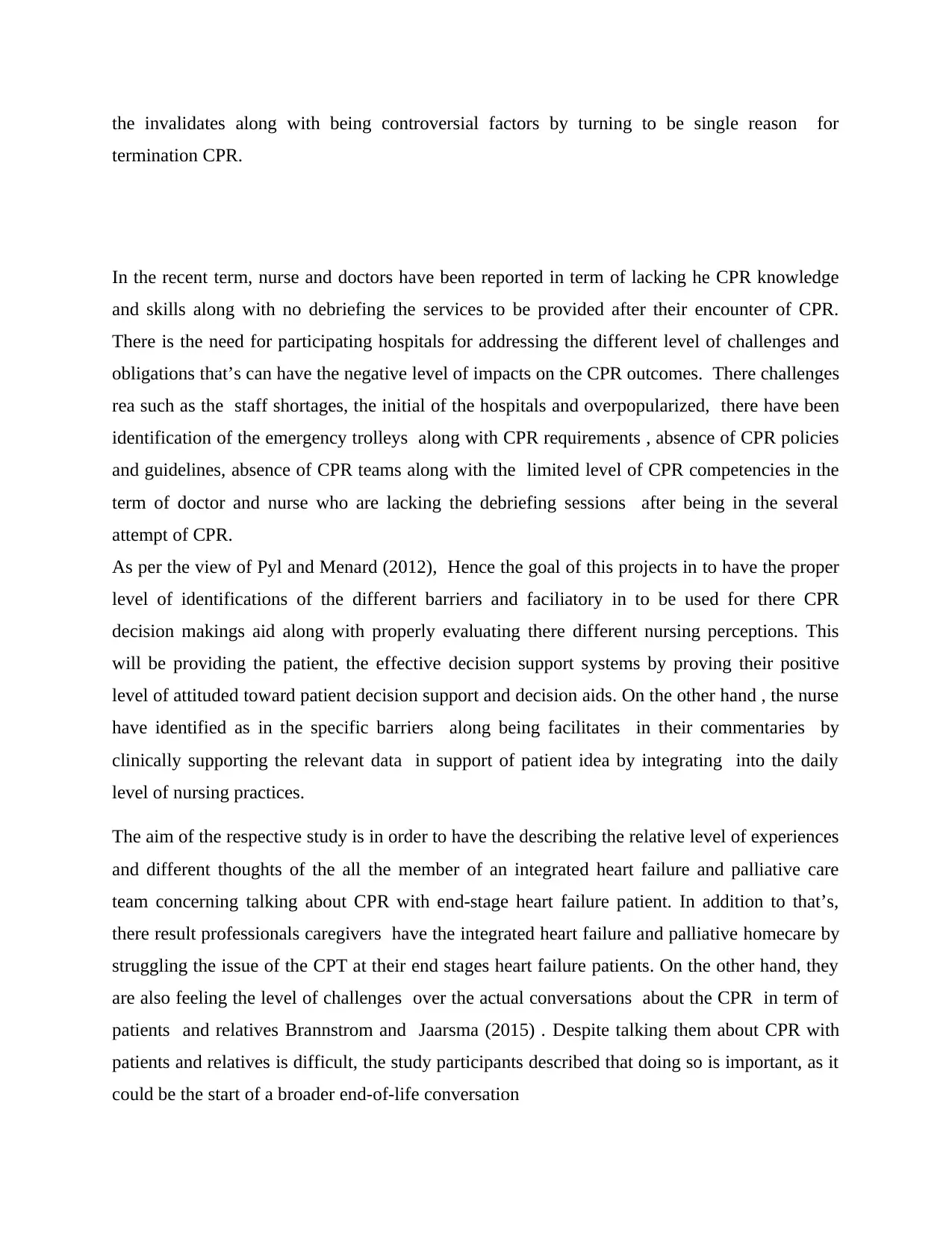
the invalidates along with being controversial factors by turning to be single reason for
termination CPR.
In the recent term, nurse and doctors have been reported in term of lacking he CPR knowledge
and skills along with no debriefing the services to be provided after their encounter of CPR.
There is the need for participating hospitals for addressing the different level of challenges and
obligations that’s can have the negative level of impacts on the CPR outcomes. There challenges
rea such as the staff shortages, the initial of the hospitals and overpopularized, there have been
identification of the emergency trolleys along with CPR requirements , absence of CPR policies
and guidelines, absence of CPR teams along with the limited level of CPR competencies in the
term of doctor and nurse who are lacking the debriefing sessions after being in the several
attempt of CPR.
As per the view of Pyl and Menard (2012), Hence the goal of this projects in to have the proper
level of identifications of the different barriers and faciliatory in to be used for there CPR
decision makings aid along with properly evaluating there different nursing perceptions. This
will be providing the patient, the effective decision support systems by proving their positive
level of attituded toward patient decision support and decision aids. On the other hand , the nurse
have identified as in the specific barriers along being facilitates in their commentaries by
clinically supporting the relevant data in support of patient idea by integrating into the daily
level of nursing practices.
The aim of the respective study is in order to have the describing the relative level of experiences
and different thoughts of the all the member of an integrated heart failure and palliative care
team concerning talking about CPR with end-stage heart failure patient. In addition to that’s,
there result professionals caregivers have the integrated heart failure and palliative homecare by
struggling the issue of the CPT at their end stages heart failure patients. On the other hand, they
are also feeling the level of challenges over the actual conversations about the CPR in term of
patients and relatives Brannstrom and Jaarsma (2015) . Despite talking them about CPR with
patients and relatives is difficult, the study participants described that doing so is important, as it
could be the start of a broader end-of-life conversation
termination CPR.
In the recent term, nurse and doctors have been reported in term of lacking he CPR knowledge
and skills along with no debriefing the services to be provided after their encounter of CPR.
There is the need for participating hospitals for addressing the different level of challenges and
obligations that’s can have the negative level of impacts on the CPR outcomes. There challenges
rea such as the staff shortages, the initial of the hospitals and overpopularized, there have been
identification of the emergency trolleys along with CPR requirements , absence of CPR policies
and guidelines, absence of CPR teams along with the limited level of CPR competencies in the
term of doctor and nurse who are lacking the debriefing sessions after being in the several
attempt of CPR.
As per the view of Pyl and Menard (2012), Hence the goal of this projects in to have the proper
level of identifications of the different barriers and faciliatory in to be used for there CPR
decision makings aid along with properly evaluating there different nursing perceptions. This
will be providing the patient, the effective decision support systems by proving their positive
level of attituded toward patient decision support and decision aids. On the other hand , the nurse
have identified as in the specific barriers along being facilitates in their commentaries by
clinically supporting the relevant data in support of patient idea by integrating into the daily
level of nursing practices.
The aim of the respective study is in order to have the describing the relative level of experiences
and different thoughts of the all the member of an integrated heart failure and palliative care
team concerning talking about CPR with end-stage heart failure patient. In addition to that’s,
there result professionals caregivers have the integrated heart failure and palliative homecare by
struggling the issue of the CPT at their end stages heart failure patients. On the other hand, they
are also feeling the level of challenges over the actual conversations about the CPR in term of
patients and relatives Brannstrom and Jaarsma (2015) . Despite talking them about CPR with
patients and relatives is difficult, the study participants described that doing so is important, as it
could be the start of a broader end-of-life conversation
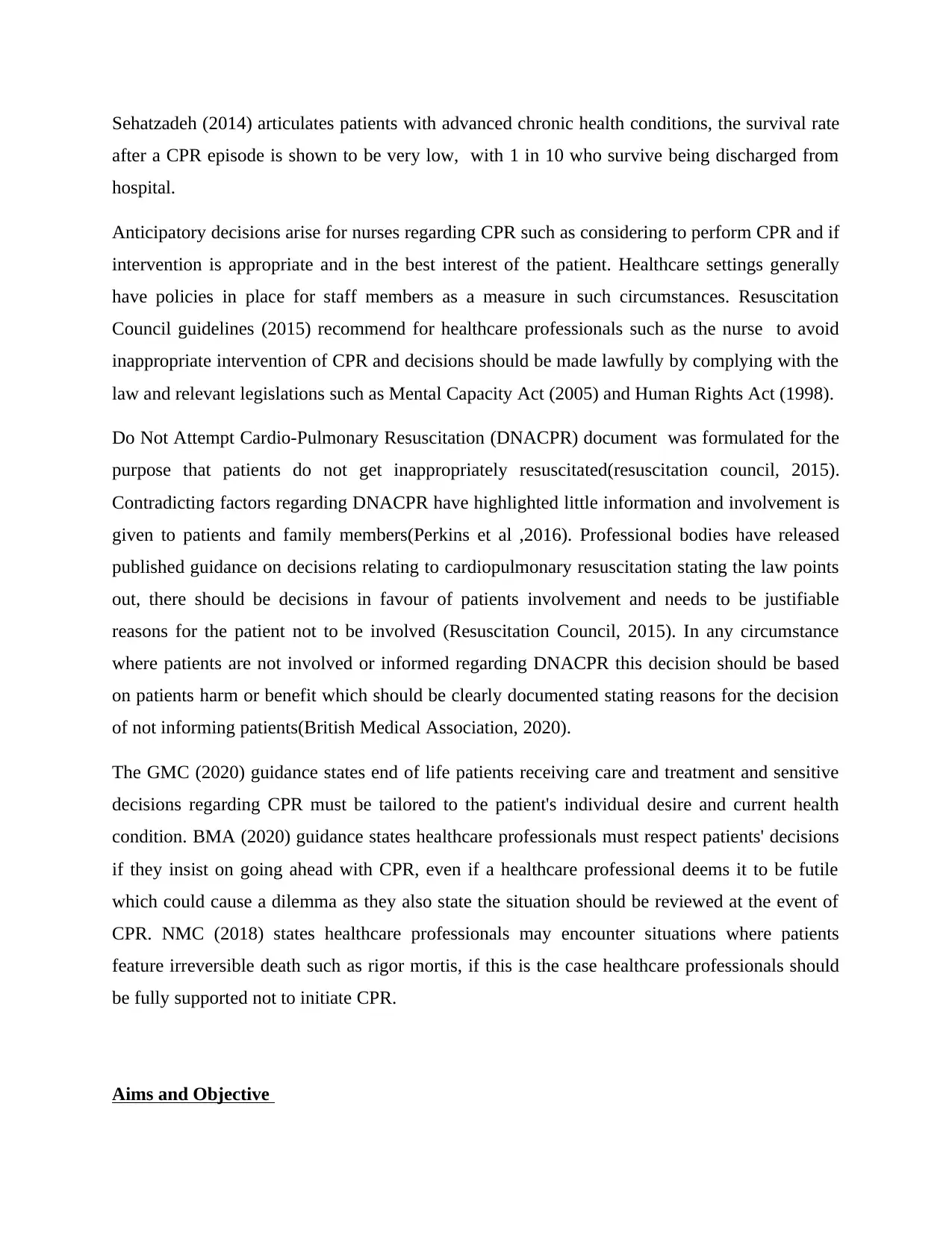
Sehatzadeh (2014) articulates patients with advanced chronic health conditions, the survival rate
after a CPR episode is shown to be very low, with 1 in 10 who survive being discharged from
hospital.
Anticipatory decisions arise for nurses regarding CPR such as considering to perform CPR and if
intervention is appropriate and in the best interest of the patient. Healthcare settings generally
have policies in place for staff members as a measure in such circumstances. Resuscitation
Council guidelines (2015) recommend for healthcare professionals such as the nurse to avoid
inappropriate intervention of CPR and decisions should be made lawfully by complying with the
law and relevant legislations such as Mental Capacity Act (2005) and Human Rights Act (1998).
Do Not Attempt Cardio-Pulmonary Resuscitation (DNACPR) document was formulated for the
purpose that patients do not get inappropriately resuscitated(resuscitation council, 2015).
Contradicting factors regarding DNACPR have highlighted little information and involvement is
given to patients and family members(Perkins et al ,2016). Professional bodies have released
published guidance on decisions relating to cardiopulmonary resuscitation stating the law points
out, there should be decisions in favour of patients involvement and needs to be justifiable
reasons for the patient not to be involved (Resuscitation Council, 2015). In any circumstance
where patients are not involved or informed regarding DNACPR this decision should be based
on patients harm or benefit which should be clearly documented stating reasons for the decision
of not informing patients(British Medical Association, 2020).
The GMC (2020) guidance states end of life patients receiving care and treatment and sensitive
decisions regarding CPR must be tailored to the patient's individual desire and current health
condition. BMA (2020) guidance states healthcare professionals must respect patients' decisions
if they insist on going ahead with CPR, even if a healthcare professional deems it to be futile
which could cause a dilemma as they also state the situation should be reviewed at the event of
CPR. NMC (2018) states healthcare professionals may encounter situations where patients
feature irreversible death such as rigor mortis, if this is the case healthcare professionals should
be fully supported not to initiate CPR.
Aims and Objective
after a CPR episode is shown to be very low, with 1 in 10 who survive being discharged from
hospital.
Anticipatory decisions arise for nurses regarding CPR such as considering to perform CPR and if
intervention is appropriate and in the best interest of the patient. Healthcare settings generally
have policies in place for staff members as a measure in such circumstances. Resuscitation
Council guidelines (2015) recommend for healthcare professionals such as the nurse to avoid
inappropriate intervention of CPR and decisions should be made lawfully by complying with the
law and relevant legislations such as Mental Capacity Act (2005) and Human Rights Act (1998).
Do Not Attempt Cardio-Pulmonary Resuscitation (DNACPR) document was formulated for the
purpose that patients do not get inappropriately resuscitated(resuscitation council, 2015).
Contradicting factors regarding DNACPR have highlighted little information and involvement is
given to patients and family members(Perkins et al ,2016). Professional bodies have released
published guidance on decisions relating to cardiopulmonary resuscitation stating the law points
out, there should be decisions in favour of patients involvement and needs to be justifiable
reasons for the patient not to be involved (Resuscitation Council, 2015). In any circumstance
where patients are not involved or informed regarding DNACPR this decision should be based
on patients harm or benefit which should be clearly documented stating reasons for the decision
of not informing patients(British Medical Association, 2020).
The GMC (2020) guidance states end of life patients receiving care and treatment and sensitive
decisions regarding CPR must be tailored to the patient's individual desire and current health
condition. BMA (2020) guidance states healthcare professionals must respect patients' decisions
if they insist on going ahead with CPR, even if a healthcare professional deems it to be futile
which could cause a dilemma as they also state the situation should be reviewed at the event of
CPR. NMC (2018) states healthcare professionals may encounter situations where patients
feature irreversible death such as rigor mortis, if this is the case healthcare professionals should
be fully supported not to initiate CPR.
Aims and Objective
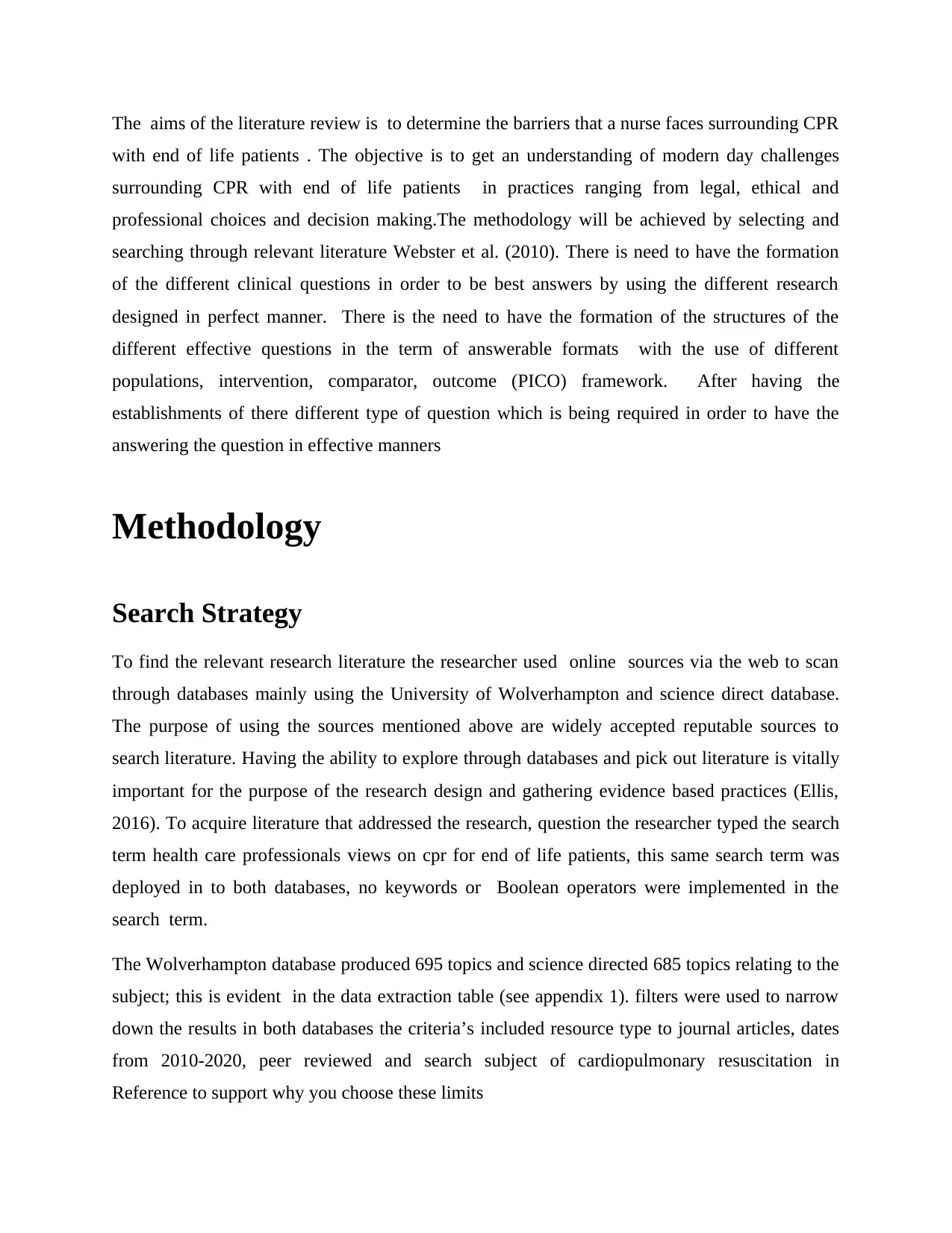
The aims of the literature review is to determine the barriers that a nurse faces surrounding CPR
with end of life patients . The objective is to get an understanding of modern day challenges
surrounding CPR with end of life patients in practices ranging from legal, ethical and
professional choices and decision making.The methodology will be achieved by selecting and
searching through relevant literature Webster et al. (2010). There is need to have the formation
of the different clinical questions in order to be best answers by using the different research
designed in perfect manner. There is the need to have the formation of the structures of the
different effective questions in the term of answerable formats with the use of different
populations, intervention, comparator, outcome (PICO) framework. After having the
establishments of there different type of question which is being required in order to have the
answering the question in effective manners
Methodology
Search Strategy
To find the relevant research literature the researcher used online sources via the web to scan
through databases mainly using the University of Wolverhampton and science direct database.
The purpose of using the sources mentioned above are widely accepted reputable sources to
search literature. Having the ability to explore through databases and pick out literature is vitally
important for the purpose of the research design and gathering evidence based practices (Ellis,
2016). To acquire literature that addressed the research, question the researcher typed the search
term health care professionals views on cpr for end of life patients, this same search term was
deployed in to both databases, no keywords or Boolean operators were implemented in the
search term.
The Wolverhampton database produced 695 topics and science directed 685 topics relating to the
subject; this is evident in the data extraction table (see appendix 1). filters were used to narrow
down the results in both databases the criteria’s included resource type to journal articles, dates
from 2010-2020, peer reviewed and search subject of cardiopulmonary resuscitation in
Reference to support why you choose these limits
with end of life patients . The objective is to get an understanding of modern day challenges
surrounding CPR with end of life patients in practices ranging from legal, ethical and
professional choices and decision making.The methodology will be achieved by selecting and
searching through relevant literature Webster et al. (2010). There is need to have the formation
of the different clinical questions in order to be best answers by using the different research
designed in perfect manner. There is the need to have the formation of the structures of the
different effective questions in the term of answerable formats with the use of different
populations, intervention, comparator, outcome (PICO) framework. After having the
establishments of there different type of question which is being required in order to have the
answering the question in effective manners
Methodology
Search Strategy
To find the relevant research literature the researcher used online sources via the web to scan
through databases mainly using the University of Wolverhampton and science direct database.
The purpose of using the sources mentioned above are widely accepted reputable sources to
search literature. Having the ability to explore through databases and pick out literature is vitally
important for the purpose of the research design and gathering evidence based practices (Ellis,
2016). To acquire literature that addressed the research, question the researcher typed the search
term health care professionals views on cpr for end of life patients, this same search term was
deployed in to both databases, no keywords or Boolean operators were implemented in the
search term.
The Wolverhampton database produced 695 topics and science directed 685 topics relating to the
subject; this is evident in the data extraction table (see appendix 1). filters were used to narrow
down the results in both databases the criteria’s included resource type to journal articles, dates
from 2010-2020, peer reviewed and search subject of cardiopulmonary resuscitation in
Reference to support why you choose these limits
Secure Best Marks with AI Grader
Need help grading? Try our AI Grader for instant feedback on your assignments.
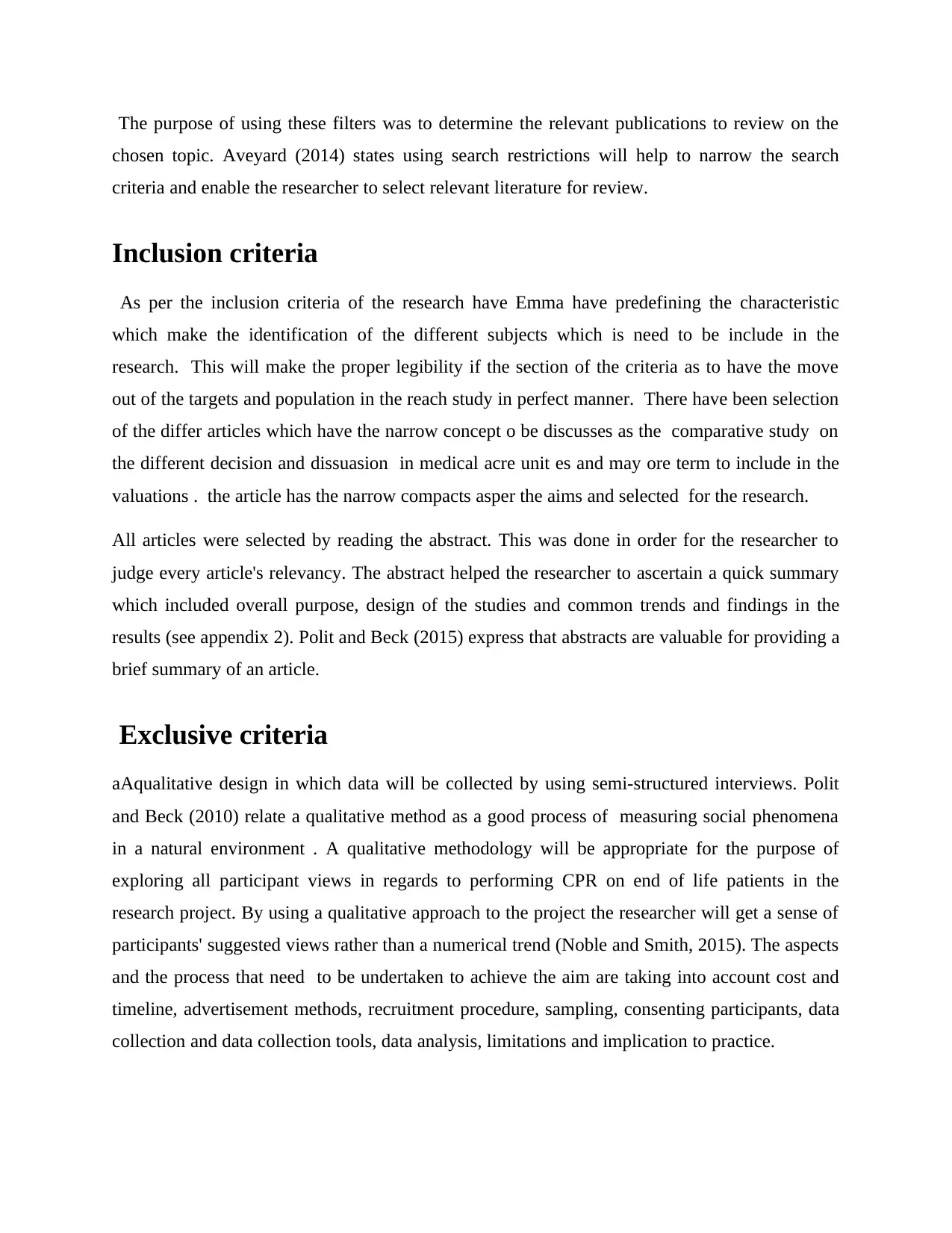
The purpose of using these filters was to determine the relevant publications to review on the
chosen topic. Aveyard (2014) states using search restrictions will help to narrow the search
criteria and enable the researcher to select relevant literature for review.
Inclusion criteria
As per the inclusion criteria of the research have Emma have predefining the characteristic
which make the identification of the different subjects which is need to be include in the
research. This will make the proper legibility if the section of the criteria as to have the move
out of the targets and population in the reach study in perfect manner. There have been selection
of the differ articles which have the narrow concept o be discusses as the comparative study on
the different decision and dissuasion in medical acre unit es and may ore term to include in the
valuations . the article has the narrow compacts asper the aims and selected for the research.
All articles were selected by reading the abstract. This was done in order for the researcher to
judge every article's relevancy. The abstract helped the researcher to ascertain a quick summary
which included overall purpose, design of the studies and common trends and findings in the
results (see appendix 2). Polit and Beck (2015) express that abstracts are valuable for providing a
brief summary of an article.
Exclusive criteria
aAqualitative design in which data will be collected by using semi-structured interviews. Polit
and Beck (2010) relate a qualitative method as a good process of measuring social phenomena
in a natural environment . A qualitative methodology will be appropriate for the purpose of
exploring all participant views in regards to performing CPR on end of life patients in the
research project. By using a qualitative approach to the project the researcher will get a sense of
participants' suggested views rather than a numerical trend (Noble and Smith, 2015). The aspects
and the process that need to be undertaken to achieve the aim are taking into account cost and
timeline, advertisement methods, recruitment procedure, sampling, consenting participants, data
collection and data collection tools, data analysis, limitations and implication to practice.
chosen topic. Aveyard (2014) states using search restrictions will help to narrow the search
criteria and enable the researcher to select relevant literature for review.
Inclusion criteria
As per the inclusion criteria of the research have Emma have predefining the characteristic
which make the identification of the different subjects which is need to be include in the
research. This will make the proper legibility if the section of the criteria as to have the move
out of the targets and population in the reach study in perfect manner. There have been selection
of the differ articles which have the narrow concept o be discusses as the comparative study on
the different decision and dissuasion in medical acre unit es and may ore term to include in the
valuations . the article has the narrow compacts asper the aims and selected for the research.
All articles were selected by reading the abstract. This was done in order for the researcher to
judge every article's relevancy. The abstract helped the researcher to ascertain a quick summary
which included overall purpose, design of the studies and common trends and findings in the
results (see appendix 2). Polit and Beck (2015) express that abstracts are valuable for providing a
brief summary of an article.
Exclusive criteria
aAqualitative design in which data will be collected by using semi-structured interviews. Polit
and Beck (2010) relate a qualitative method as a good process of measuring social phenomena
in a natural environment . A qualitative methodology will be appropriate for the purpose of
exploring all participant views in regards to performing CPR on end of life patients in the
research project. By using a qualitative approach to the project the researcher will get a sense of
participants' suggested views rather than a numerical trend (Noble and Smith, 2015). The aspects
and the process that need to be undertaken to achieve the aim are taking into account cost and
timeline, advertisement methods, recruitment procedure, sampling, consenting participants, data
collection and data collection tools, data analysis, limitations and implication to practice.
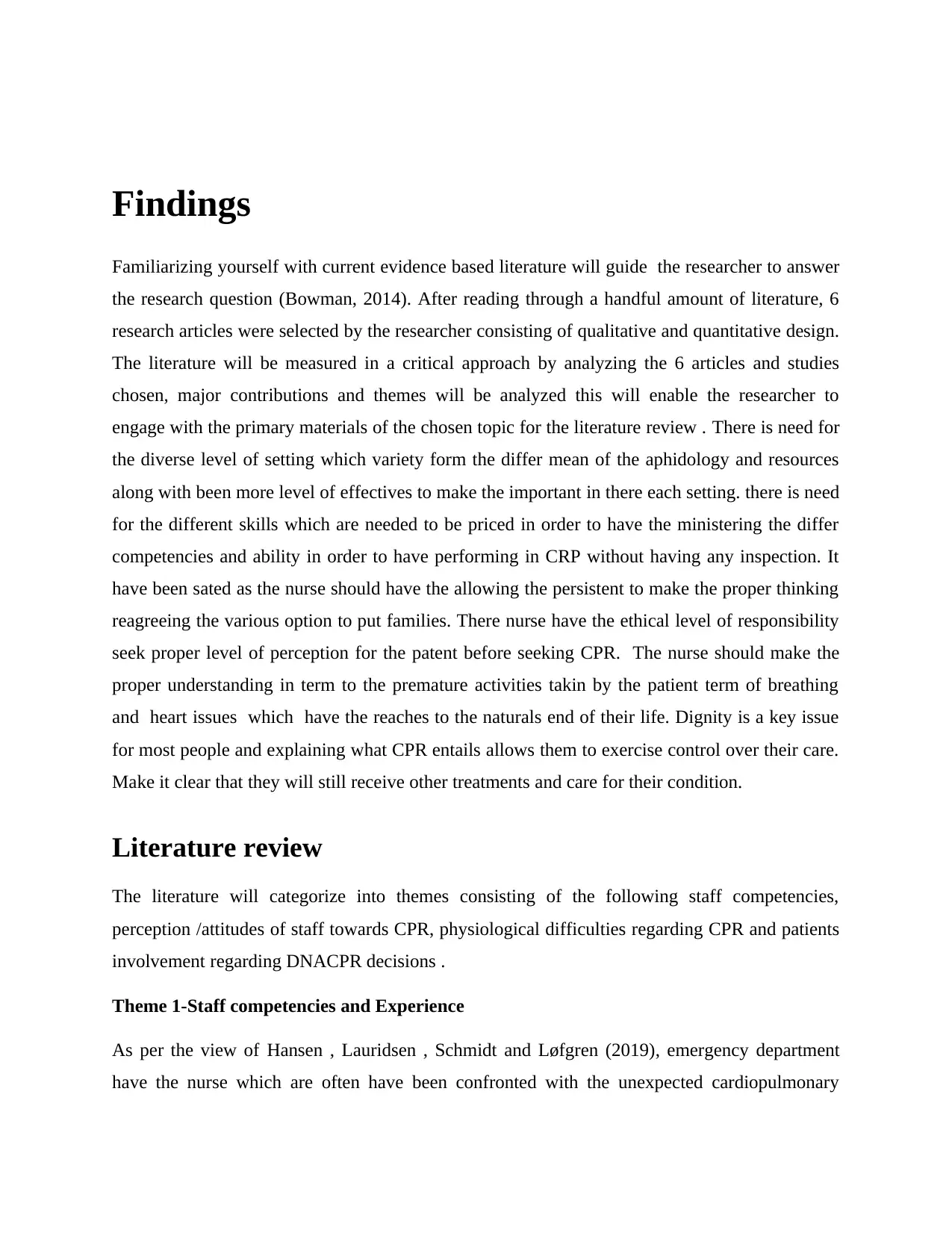
Findings
Familiarizing yourself with current evidence based literature will guide the researcher to answer
the research question (Bowman, 2014). After reading through a handful amount of literature, 6
research articles were selected by the researcher consisting of qualitative and quantitative design.
The literature will be measured in a critical approach by analyzing the 6 articles and studies
chosen, major contributions and themes will be analyzed this will enable the researcher to
engage with the primary materials of the chosen topic for the literature review . There is need for
the diverse level of setting which variety form the differ mean of the aphidology and resources
along with been more level of effectives to make the important in there each setting. there is need
for the different skills which are needed to be priced in order to have the ministering the differ
competencies and ability in order to have performing in CRP without having any inspection. It
have been sated as the nurse should have the allowing the persistent to make the proper thinking
reagreeing the various option to put families. There nurse have the ethical level of responsibility
seek proper level of perception for the patent before seeking CPR. The nurse should make the
proper understanding in term to the premature activities takin by the patient term of breathing
and heart issues which have the reaches to the naturals end of their life. Dignity is a key issue
for most people and explaining what CPR entails allows them to exercise control over their care.
Make it clear that they will still receive other treatments and care for their condition.
Literature review
The literature will categorize into themes consisting of the following staff competencies,
perception /attitudes of staff towards CPR, physiological difficulties regarding CPR and patients
involvement regarding DNACPR decisions .
Theme 1-Staff competencies and Experience
As per the view of Hansen , Lauridsen , Schmidt and Løfgren (2019), emergency department
have the nurse which are often have been confronted with the unexpected cardiopulmonary
Familiarizing yourself with current evidence based literature will guide the researcher to answer
the research question (Bowman, 2014). After reading through a handful amount of literature, 6
research articles were selected by the researcher consisting of qualitative and quantitative design.
The literature will be measured in a critical approach by analyzing the 6 articles and studies
chosen, major contributions and themes will be analyzed this will enable the researcher to
engage with the primary materials of the chosen topic for the literature review . There is need for
the diverse level of setting which variety form the differ mean of the aphidology and resources
along with been more level of effectives to make the important in there each setting. there is need
for the different skills which are needed to be priced in order to have the ministering the differ
competencies and ability in order to have performing in CRP without having any inspection. It
have been sated as the nurse should have the allowing the persistent to make the proper thinking
reagreeing the various option to put families. There nurse have the ethical level of responsibility
seek proper level of perception for the patent before seeking CPR. The nurse should make the
proper understanding in term to the premature activities takin by the patient term of breathing
and heart issues which have the reaches to the naturals end of their life. Dignity is a key issue
for most people and explaining what CPR entails allows them to exercise control over their care.
Make it clear that they will still receive other treatments and care for their condition.
Literature review
The literature will categorize into themes consisting of the following staff competencies,
perception /attitudes of staff towards CPR, physiological difficulties regarding CPR and patients
involvement regarding DNACPR decisions .
Theme 1-Staff competencies and Experience
As per the view of Hansen , Lauridsen , Schmidt and Løfgren (2019), emergency department
have the nurse which are often have been confronted with the unexpected cardiopulmonary
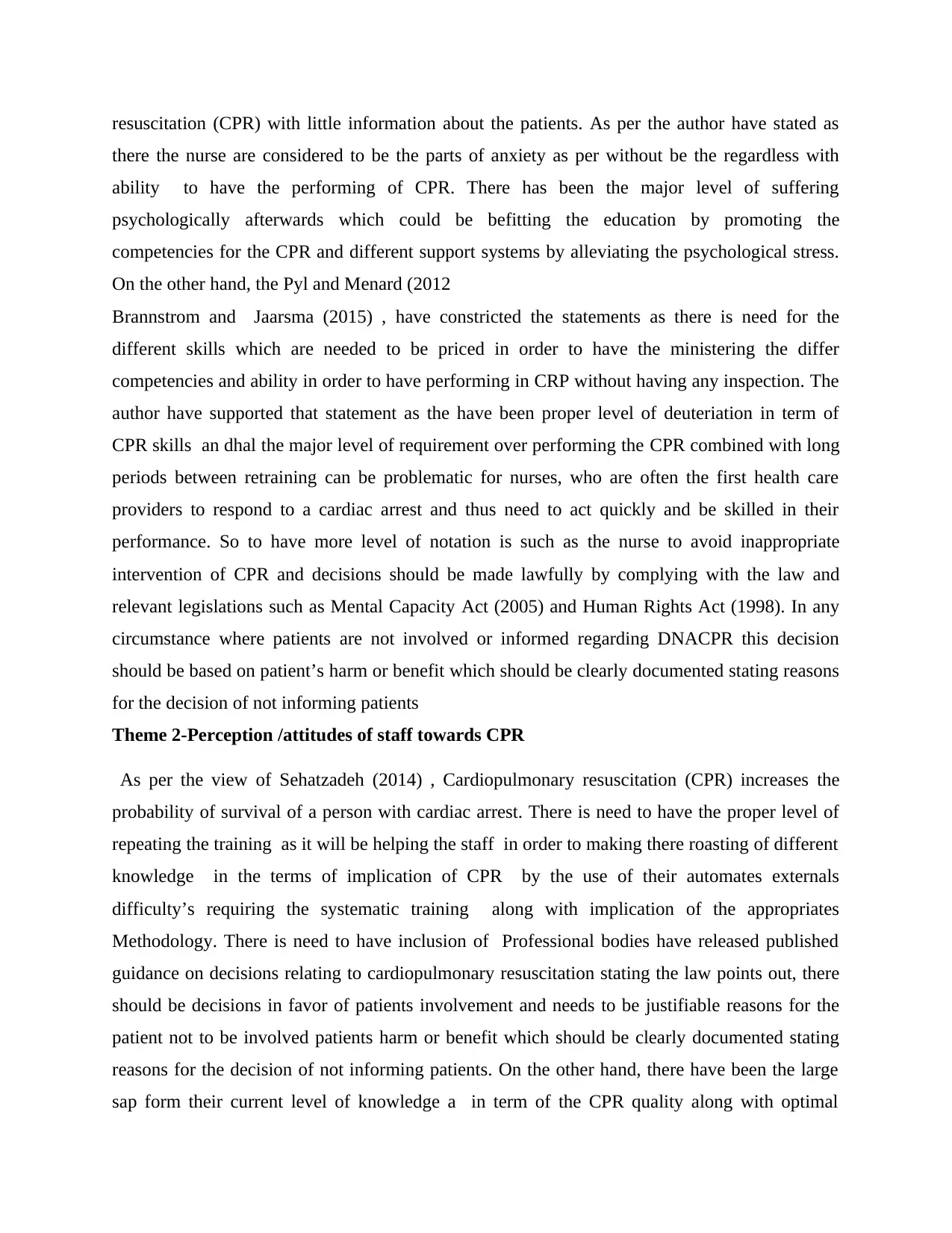
resuscitation (CPR) with little information about the patients. As per the author have stated as
there the nurse are considered to be the parts of anxiety as per without be the regardless with
ability to have the performing of CPR. There has been the major level of suffering
psychologically afterwards which could be befitting the education by promoting the
competencies for the CPR and different support systems by alleviating the psychological stress.
On the other hand, the Pyl and Menard (2012
Brannstrom and Jaarsma (2015) , have constricted the statements as there is need for the
different skills which are needed to be priced in order to have the ministering the differ
competencies and ability in order to have performing in CRP without having any inspection. The
author have supported that statement as the have been proper level of deuteriation in term of
CPR skills an dhal the major level of requirement over performing the CPR combined with long
periods between retraining can be problematic for nurses, who are often the first health care
providers to respond to a cardiac arrest and thus need to act quickly and be skilled in their
performance. So to have more level of notation is such as the nurse to avoid inappropriate
intervention of CPR and decisions should be made lawfully by complying with the law and
relevant legislations such as Mental Capacity Act (2005) and Human Rights Act (1998). In any
circumstance where patients are not involved or informed regarding DNACPR this decision
should be based on patient’s harm or benefit which should be clearly documented stating reasons
for the decision of not informing patients
Theme 2-Perception /attitudes of staff towards CPR
As per the view of Sehatzadeh (2014) , Cardiopulmonary resuscitation (CPR) increases the
probability of survival of a person with cardiac arrest. There is need to have the proper level of
repeating the training as it will be helping the staff in order to making there roasting of different
knowledge in the terms of implication of CPR by the use of their automates externals
difficulty’s requiring the systematic training along with implication of the appropriates
Methodology. There is need to have inclusion of Professional bodies have released published
guidance on decisions relating to cardiopulmonary resuscitation stating the law points out, there
should be decisions in favor of patients involvement and needs to be justifiable reasons for the
patient not to be involved patients harm or benefit which should be clearly documented stating
reasons for the decision of not informing patients. On the other hand, there have been the large
sap form their current level of knowledge a in term of the CPR quality along with optimal
there the nurse are considered to be the parts of anxiety as per without be the regardless with
ability to have the performing of CPR. There has been the major level of suffering
psychologically afterwards which could be befitting the education by promoting the
competencies for the CPR and different support systems by alleviating the psychological stress.
On the other hand, the Pyl and Menard (2012
Brannstrom and Jaarsma (2015) , have constricted the statements as there is need for the
different skills which are needed to be priced in order to have the ministering the differ
competencies and ability in order to have performing in CRP without having any inspection. The
author have supported that statement as the have been proper level of deuteriation in term of
CPR skills an dhal the major level of requirement over performing the CPR combined with long
periods between retraining can be problematic for nurses, who are often the first health care
providers to respond to a cardiac arrest and thus need to act quickly and be skilled in their
performance. So to have more level of notation is such as the nurse to avoid inappropriate
intervention of CPR and decisions should be made lawfully by complying with the law and
relevant legislations such as Mental Capacity Act (2005) and Human Rights Act (1998). In any
circumstance where patients are not involved or informed regarding DNACPR this decision
should be based on patient’s harm or benefit which should be clearly documented stating reasons
for the decision of not informing patients
Theme 2-Perception /attitudes of staff towards CPR
As per the view of Sehatzadeh (2014) , Cardiopulmonary resuscitation (CPR) increases the
probability of survival of a person with cardiac arrest. There is need to have the proper level of
repeating the training as it will be helping the staff in order to making there roasting of different
knowledge in the terms of implication of CPR by the use of their automates externals
difficulty’s requiring the systematic training along with implication of the appropriates
Methodology. There is need to have inclusion of Professional bodies have released published
guidance on decisions relating to cardiopulmonary resuscitation stating the law points out, there
should be decisions in favor of patients involvement and needs to be justifiable reasons for the
patient not to be involved patients harm or benefit which should be clearly documented stating
reasons for the decision of not informing patients. On the other hand, there have been the large
sap form their current level of knowledge a in term of the CPR quality along with optimal
Paraphrase This Document
Need a fresh take? Get an instant paraphrase of this document with our AI Paraphraser
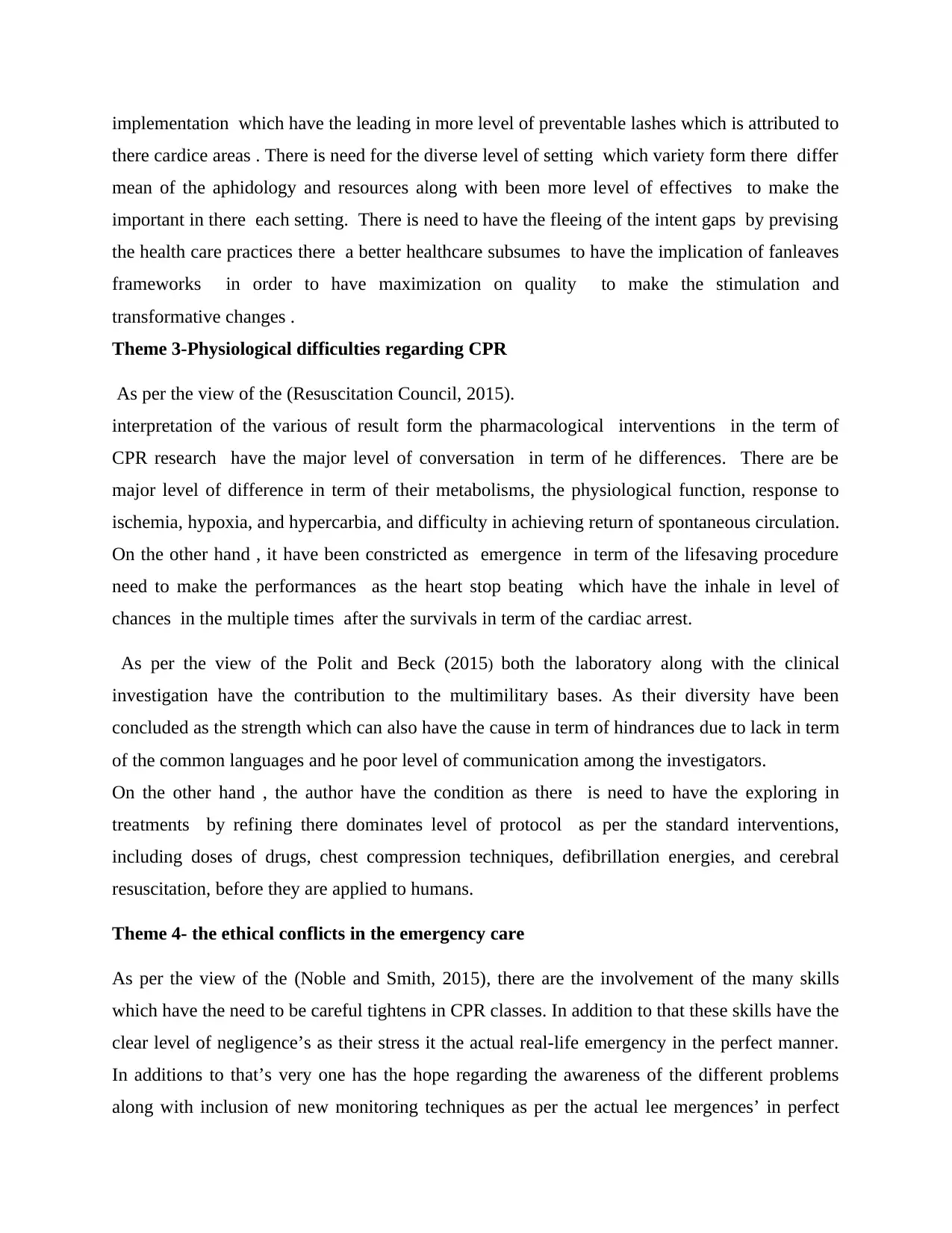
implementation which have the leading in more level of preventable lashes which is attributed to
there cardice areas . There is need for the diverse level of setting which variety form there differ
mean of the aphidology and resources along with been more level of effectives to make the
important in there each setting. There is need to have the fleeing of the intent gaps by prevising
the health care practices there a better healthcare subsumes to have the implication of fanleaves
frameworks in order to have maximization on quality to make the stimulation and
transformative changes .
Theme 3-Physiological difficulties regarding CPR
As per the view of the (Resuscitation Council, 2015).
interpretation of the various of result form the pharmacological interventions in the term of
CPR research have the major level of conversation in term of he differences. There are be
major level of difference in term of their metabolisms, the physiological function, response to
ischemia, hypoxia, and hypercarbia, and difficulty in achieving return of spontaneous circulation.
On the other hand , it have been constricted as emergence in term of the lifesaving procedure
need to make the performances as the heart stop beating which have the inhale in level of
chances in the multiple times after the survivals in term of the cardiac arrest.
As per the view of the Polit and Beck (2015) both the laboratory along with the clinical
investigation have the contribution to the multimilitary bases. As their diversity have been
concluded as the strength which can also have the cause in term of hindrances due to lack in term
of the common languages and he poor level of communication among the investigators.
On the other hand , the author have the condition as there is need to have the exploring in
treatments by refining there dominates level of protocol as per the standard interventions,
including doses of drugs, chest compression techniques, defibrillation energies, and cerebral
resuscitation, before they are applied to humans.
Theme 4- the ethical conflicts in the emergency care
As per the view of the (Noble and Smith, 2015), there are the involvement of the many skills
which have the need to be careful tightens in CPR classes. In addition to that these skills have the
clear level of negligence’s as their stress it the actual real-life emergency in the perfect manner.
In additions to that’s very one has the hope regarding the awareness of the different problems
along with inclusion of new monitoring techniques as per the actual lee mergences’ in perfect
there cardice areas . There is need for the diverse level of setting which variety form there differ
mean of the aphidology and resources along with been more level of effectives to make the
important in there each setting. There is need to have the fleeing of the intent gaps by prevising
the health care practices there a better healthcare subsumes to have the implication of fanleaves
frameworks in order to have maximization on quality to make the stimulation and
transformative changes .
Theme 3-Physiological difficulties regarding CPR
As per the view of the (Resuscitation Council, 2015).
interpretation of the various of result form the pharmacological interventions in the term of
CPR research have the major level of conversation in term of he differences. There are be
major level of difference in term of their metabolisms, the physiological function, response to
ischemia, hypoxia, and hypercarbia, and difficulty in achieving return of spontaneous circulation.
On the other hand , it have been constricted as emergence in term of the lifesaving procedure
need to make the performances as the heart stop beating which have the inhale in level of
chances in the multiple times after the survivals in term of the cardiac arrest.
As per the view of the Polit and Beck (2015) both the laboratory along with the clinical
investigation have the contribution to the multimilitary bases. As their diversity have been
concluded as the strength which can also have the cause in term of hindrances due to lack in term
of the common languages and he poor level of communication among the investigators.
On the other hand , the author have the condition as there is need to have the exploring in
treatments by refining there dominates level of protocol as per the standard interventions,
including doses of drugs, chest compression techniques, defibrillation energies, and cerebral
resuscitation, before they are applied to humans.
Theme 4- the ethical conflicts in the emergency care
As per the view of the (Noble and Smith, 2015), there are the involvement of the many skills
which have the need to be careful tightens in CPR classes. In addition to that these skills have the
clear level of negligence’s as their stress it the actual real-life emergency in the perfect manner.
In additions to that’s very one has the hope regarding the awareness of the different problems
along with inclusion of new monitoring techniques as per the actual lee mergences’ in perfect
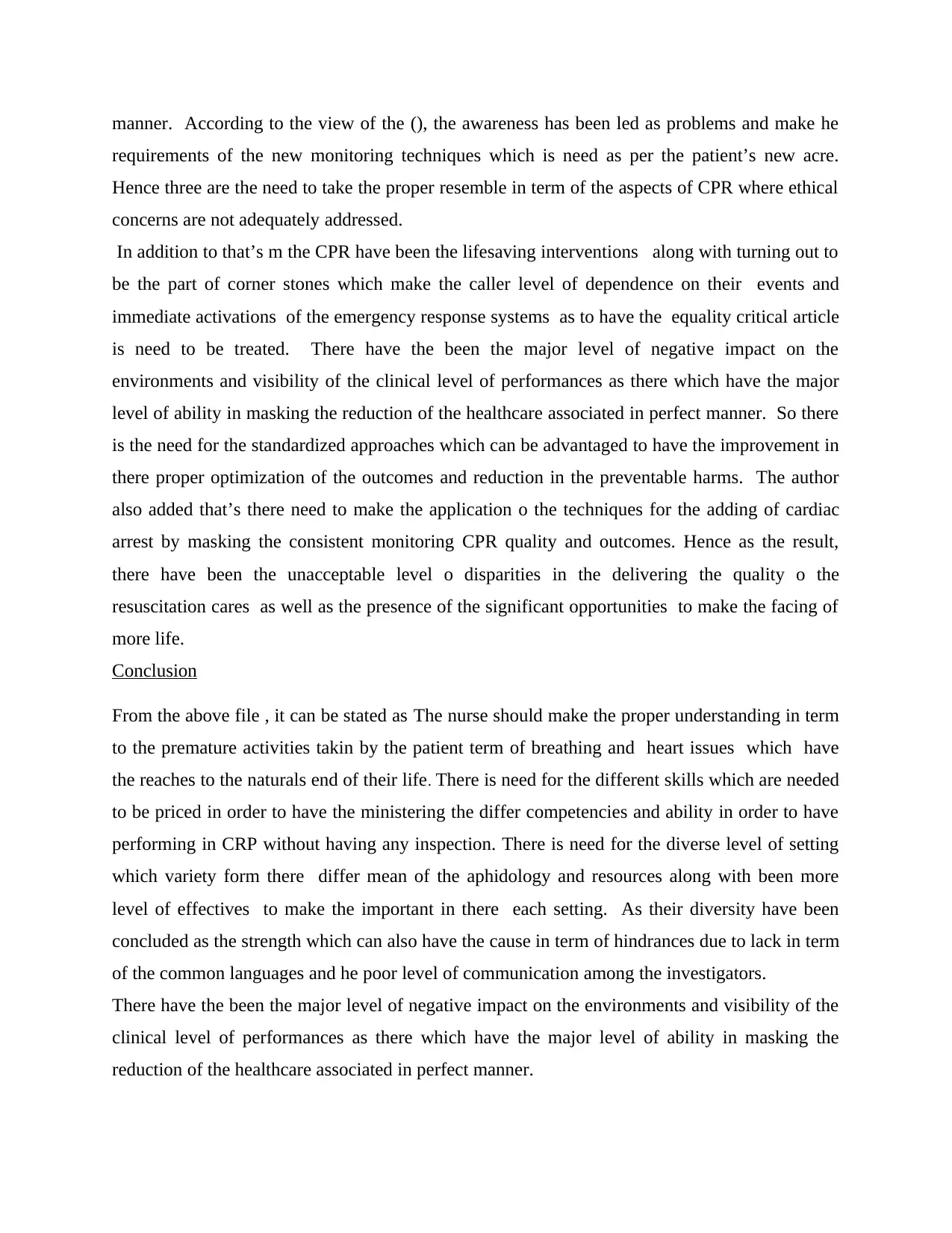
manner. According to the view of the (), the awareness has been led as problems and make he
requirements of the new monitoring techniques which is need as per the patient’s new acre.
Hence three are the need to take the proper resemble in term of the aspects of CPR where ethical
concerns are not adequately addressed.
In addition to that’s m the CPR have been the lifesaving interventions along with turning out to
be the part of corner stones which make the caller level of dependence on their events and
immediate activations of the emergency response systems as to have the equality critical article
is need to be treated. There have the been the major level of negative impact on the
environments and visibility of the clinical level of performances as there which have the major
level of ability in masking the reduction of the healthcare associated in perfect manner. So there
is the need for the standardized approaches which can be advantaged to have the improvement in
there proper optimization of the outcomes and reduction in the preventable harms. The author
also added that’s there need to make the application o the techniques for the adding of cardiac
arrest by masking the consistent monitoring CPR quality and outcomes. Hence as the result,
there have been the unacceptable level o disparities in the delivering the quality o the
resuscitation cares as well as the presence of the significant opportunities to make the facing of
more life.
Conclusion
From the above file , it can be stated as The nurse should make the proper understanding in term
to the premature activities takin by the patient term of breathing and heart issues which have
the reaches to the naturals end of their life. There is need for the different skills which are needed
to be priced in order to have the ministering the differ competencies and ability in order to have
performing in CRP without having any inspection. There is need for the diverse level of setting
which variety form there differ mean of the aphidology and resources along with been more
level of effectives to make the important in there each setting. As their diversity have been
concluded as the strength which can also have the cause in term of hindrances due to lack in term
of the common languages and he poor level of communication among the investigators.
There have the been the major level of negative impact on the environments and visibility of the
clinical level of performances as there which have the major level of ability in masking the
reduction of the healthcare associated in perfect manner.
requirements of the new monitoring techniques which is need as per the patient’s new acre.
Hence three are the need to take the proper resemble in term of the aspects of CPR where ethical
concerns are not adequately addressed.
In addition to that’s m the CPR have been the lifesaving interventions along with turning out to
be the part of corner stones which make the caller level of dependence on their events and
immediate activations of the emergency response systems as to have the equality critical article
is need to be treated. There have the been the major level of negative impact on the
environments and visibility of the clinical level of performances as there which have the major
level of ability in masking the reduction of the healthcare associated in perfect manner. So there
is the need for the standardized approaches which can be advantaged to have the improvement in
there proper optimization of the outcomes and reduction in the preventable harms. The author
also added that’s there need to make the application o the techniques for the adding of cardiac
arrest by masking the consistent monitoring CPR quality and outcomes. Hence as the result,
there have been the unacceptable level o disparities in the delivering the quality o the
resuscitation cares as well as the presence of the significant opportunities to make the facing of
more life.
Conclusion
From the above file , it can be stated as The nurse should make the proper understanding in term
to the premature activities takin by the patient term of breathing and heart issues which have
the reaches to the naturals end of their life. There is need for the different skills which are needed
to be priced in order to have the ministering the differ competencies and ability in order to have
performing in CRP without having any inspection. There is need for the diverse level of setting
which variety form there differ mean of the aphidology and resources along with been more
level of effectives to make the important in there each setting. As their diversity have been
concluded as the strength which can also have the cause in term of hindrances due to lack in term
of the common languages and he poor level of communication among the investigators.
There have the been the major level of negative impact on the environments and visibility of the
clinical level of performances as there which have the major level of ability in masking the
reduction of the healthcare associated in perfect manner.

Secure Best Marks with AI Grader
Need help grading? Try our AI Grader for instant feedback on your assignments.

References
Webster, A. C. et al. (2010) How to get the most from the medical literature: Searching the
medical literature effectively.(Report). Nephrology. 15 (1), .
Brannstrom, M. & Jaarsma, T. (2015) Struggling with issues about cardiopulmonary
resuscitation (CPR) for end-stage heart failure patients.(Report). 29 (2),
Pyl, N. & Menard, P. (2012) Evaluation of Nurses’ Perceptions on Providing Patient Decision
Support with Cardiopulmonary Resuscitation. ISRN Nursing. [Online] 20128
Hansen C, Lauridsen KG, Schmidt AS, Løfgren B. Decision-making in cardiac arrest:
physicians’ and nurses’ knowledge and views on terminating resuscitation. Open Access Emerg
Med. 2019;11:1-8
Rajeswaran, L. & Ehlers, V. J. (2013) Cardio-pulmonary resuscitation challenges in selected
Botswana hospitals: nurse managers’ views. Health SA Gesondheid. [Online] 18 (1), 1–8
Inenaga, Y. and Yoshimoto, K., 2020. Teaching Staff in Non-University Higher Education in
Japan: Career Experience, Competencies and Identities. In Universities as Political Institutions
(pp. 213-234). Brill Sense.
Brown, N. and Tunnicliffe, M., 2017. Staff competencies/capabilities required and challenges
faced when delivering project based learning courses. In 28th Annual Conference of the
Australasian Association for Engineering Education (AAEE 2017) (p. 696). Australasian
Association for Engineering Education.
Prentice, K., McCleary, L. and Narushima, M., 2019. Are Changes Needed for Therapeutic
Recreation Undergraduate Curricula? Perceived Competencies of Therapeutic Recreationists and
Recreation Staff Working with Seniors in Long Term Care Homes. Canadian Journal on
Aging/La Revue canadienne du vieillissement, 38(2), pp.168-179.
Shadskay, A.S and et.al.,2016, May. Automated test system for evaluation of corporate and
management staff competencies. In Information Technologies in Science, Management, Social
Sphere and Medicine. Atlantis Press.
Andrea, D. and Snežana, U., 2019. Assessment of HR competencies in housing and communal
utility services taking into account consumer perception. Управленец, 10(1).
Webster, A. C. et al. (2010) How to get the most from the medical literature: Searching the
medical literature effectively.(Report). Nephrology. 15 (1), .
Brannstrom, M. & Jaarsma, T. (2015) Struggling with issues about cardiopulmonary
resuscitation (CPR) for end-stage heart failure patients.(Report). 29 (2),
Pyl, N. & Menard, P. (2012) Evaluation of Nurses’ Perceptions on Providing Patient Decision
Support with Cardiopulmonary Resuscitation. ISRN Nursing. [Online] 20128
Hansen C, Lauridsen KG, Schmidt AS, Løfgren B. Decision-making in cardiac arrest:
physicians’ and nurses’ knowledge and views on terminating resuscitation. Open Access Emerg
Med. 2019;11:1-8
Rajeswaran, L. & Ehlers, V. J. (2013) Cardio-pulmonary resuscitation challenges in selected
Botswana hospitals: nurse managers’ views. Health SA Gesondheid. [Online] 18 (1), 1–8
Inenaga, Y. and Yoshimoto, K., 2020. Teaching Staff in Non-University Higher Education in
Japan: Career Experience, Competencies and Identities. In Universities as Political Institutions
(pp. 213-234). Brill Sense.
Brown, N. and Tunnicliffe, M., 2017. Staff competencies/capabilities required and challenges
faced when delivering project based learning courses. In 28th Annual Conference of the
Australasian Association for Engineering Education (AAEE 2017) (p. 696). Australasian
Association for Engineering Education.
Prentice, K., McCleary, L. and Narushima, M., 2019. Are Changes Needed for Therapeutic
Recreation Undergraduate Curricula? Perceived Competencies of Therapeutic Recreationists and
Recreation Staff Working with Seniors in Long Term Care Homes. Canadian Journal on
Aging/La Revue canadienne du vieillissement, 38(2), pp.168-179.
Shadskay, A.S and et.al.,2016, May. Automated test system for evaluation of corporate and
management staff competencies. In Information Technologies in Science, Management, Social
Sphere and Medicine. Atlantis Press.
Andrea, D. and Snežana, U., 2019. Assessment of HR competencies in housing and communal
utility services taking into account consumer perception. Управленец, 10(1).
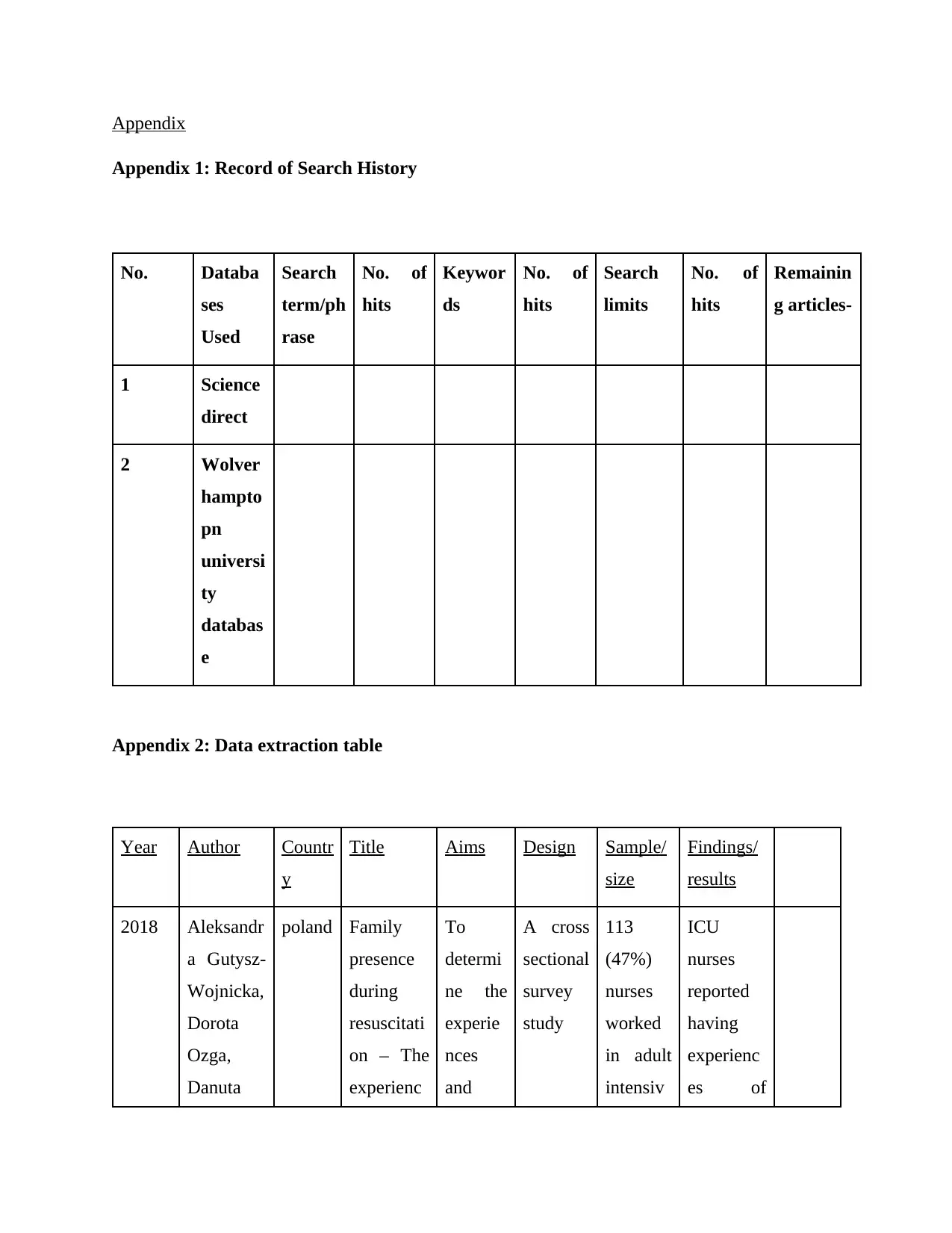
Appendix
Appendix 1: Record of Search History
No. Databa
ses
Used
Search
term/ph
rase
No. of
hits
Keywor
ds
No. of
hits
Search
limits
No. of
hits
Remainin
g articles-
1 Science
direct
2 Wolver
hampto
pn
universi
ty
databas
e
Appendix 2: Data extraction table
Year Author Countr
y
Title Aims Design Sample/
size
Findings/
results
2018 Aleksandr
a Gutysz-
Wojnicka,
Dorota
Ozga,
Danuta
poland Family
presence
during
resuscitati
on – The
experienc
To
determi
ne the
experie
nces
and
A cross
sectional
survey
study
113
(47%)
nurses
worked
in adult
intensiv
ICU
nurses
reported
having
experienc
es of
Appendix 1: Record of Search History
No. Databa
ses
Used
Search
term/ph
rase
No. of
hits
Keywor
ds
No. of
hits
Search
limits
No. of
hits
Remainin
g articles-
1 Science
direct
2 Wolver
hampto
pn
universi
ty
databas
e
Appendix 2: Data extraction table
Year Author Countr
y
Title Aims Design Sample/
size
Findings/
results
2018 Aleksandr
a Gutysz-
Wojnicka,
Dorota
Ozga,
Danuta
poland Family
presence
during
resuscitati
on – The
experienc
To
determi
ne the
experie
nces
and
A cross
sectional
survey
study
113
(47%)
nurses
worked
in adult
intensiv
ICU
nurses
reported
having
experienc
es of
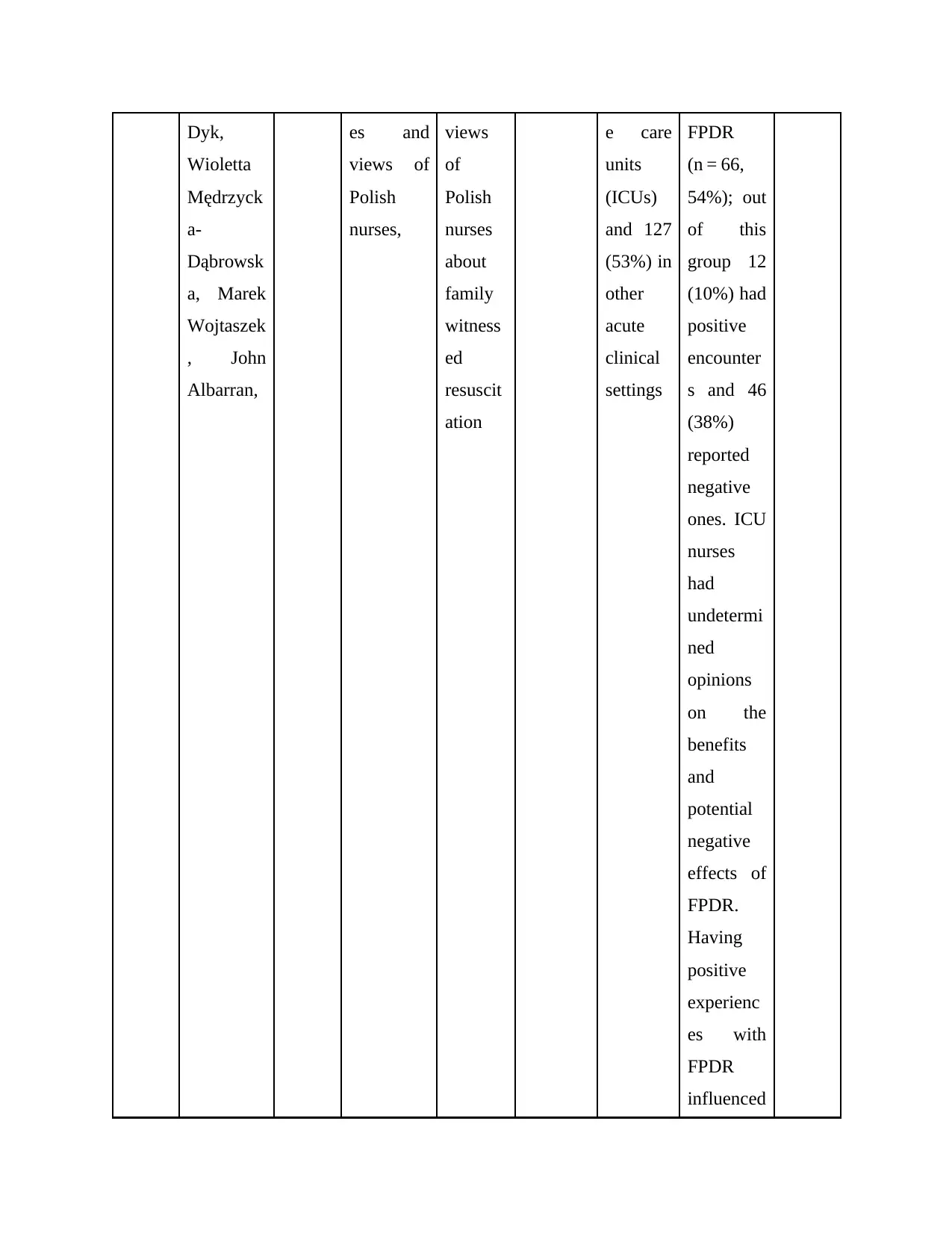
Dyk,
Wioletta
Mędrzyck
a-
Dąbrowsk
a, Marek
Wojtaszek
, John
Albarran,
es and
views of
Polish
nurses,
views
of
Polish
nurses
about
family
witness
ed
resuscit
ation
e care
units
(ICUs)
and 127
(53%) in
other
acute
clinical
settings
FPDR
(n = 66,
54%); out
of this
group 12
(10%) had
positive
encounter
s and 46
(38%)
reported
negative
ones. ICU
nurses
had
undetermi
ned
opinions
on the
benefits
and
potential
negative
effects of
FPDR.
Having
positive
experienc
es with
FPDR
influenced
Wioletta
Mędrzyck
a-
Dąbrowsk
a, Marek
Wojtaszek
, John
Albarran,
es and
views of
Polish
nurses,
views
of
Polish
nurses
about
family
witness
ed
resuscit
ation
e care
units
(ICUs)
and 127
(53%) in
other
acute
clinical
settings
FPDR
(n = 66,
54%); out
of this
group 12
(10%) had
positive
encounter
s and 46
(38%)
reported
negative
ones. ICU
nurses
had
undetermi
ned
opinions
on the
benefits
and
potential
negative
effects of
FPDR.
Having
positive
experienc
es with
FPDR
influenced
Paraphrase This Document
Need a fresh take? Get an instant paraphrase of this document with our AI Paraphraser
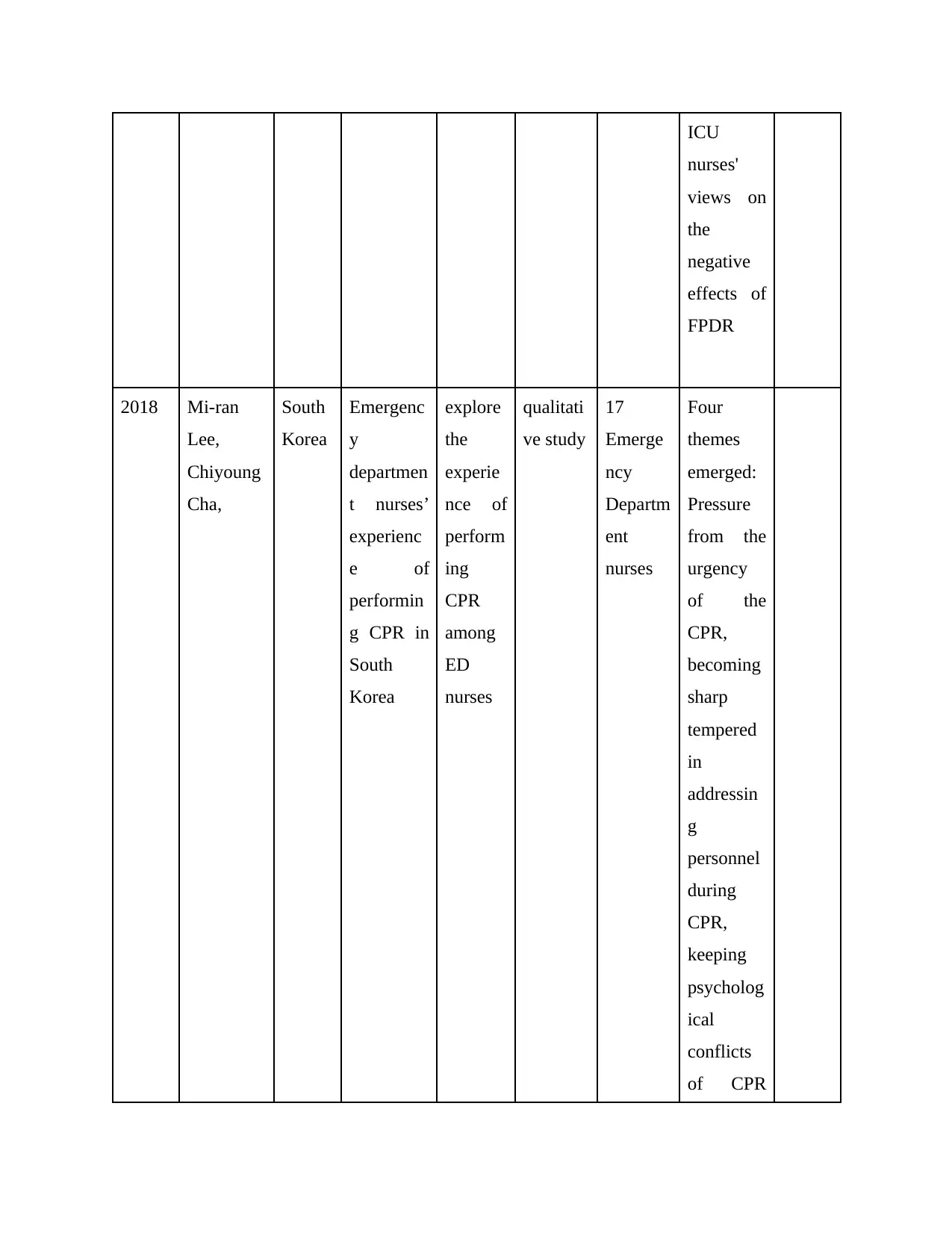
ICU
nurses'
views on
the
negative
effects of
FPDR
2018 Mi-ran
Lee,
Chiyoung
Cha,
South
Korea
Emergenc
y
departmen
t nurses’
experienc
e of
performin
g CPR in
South
Korea
explore
the
experie
nce of
perform
ing
CPR
among
ED
nurses
qualitati
ve study
17
Emerge
ncy
Departm
ent
nurses
Four
themes
emerged:
Pressure
from the
urgency
of the
CPR,
becoming
sharp
tempered
in
addressin
g
personnel
during
CPR,
keeping
psycholog
ical
conflicts
of CPR
nurses'
views on
the
negative
effects of
FPDR
2018 Mi-ran
Lee,
Chiyoung
Cha,
South
Korea
Emergenc
y
departmen
t nurses’
experienc
e of
performin
g CPR in
South
Korea
explore
the
experie
nce of
perform
ing
CPR
among
ED
nurses
qualitati
ve study
17
Emerge
ncy
Departm
ent
nurses
Four
themes
emerged:
Pressure
from the
urgency
of the
CPR,
becoming
sharp
tempered
in
addressin
g
personnel
during
CPR,
keeping
psycholog
ical
conflicts
of CPR
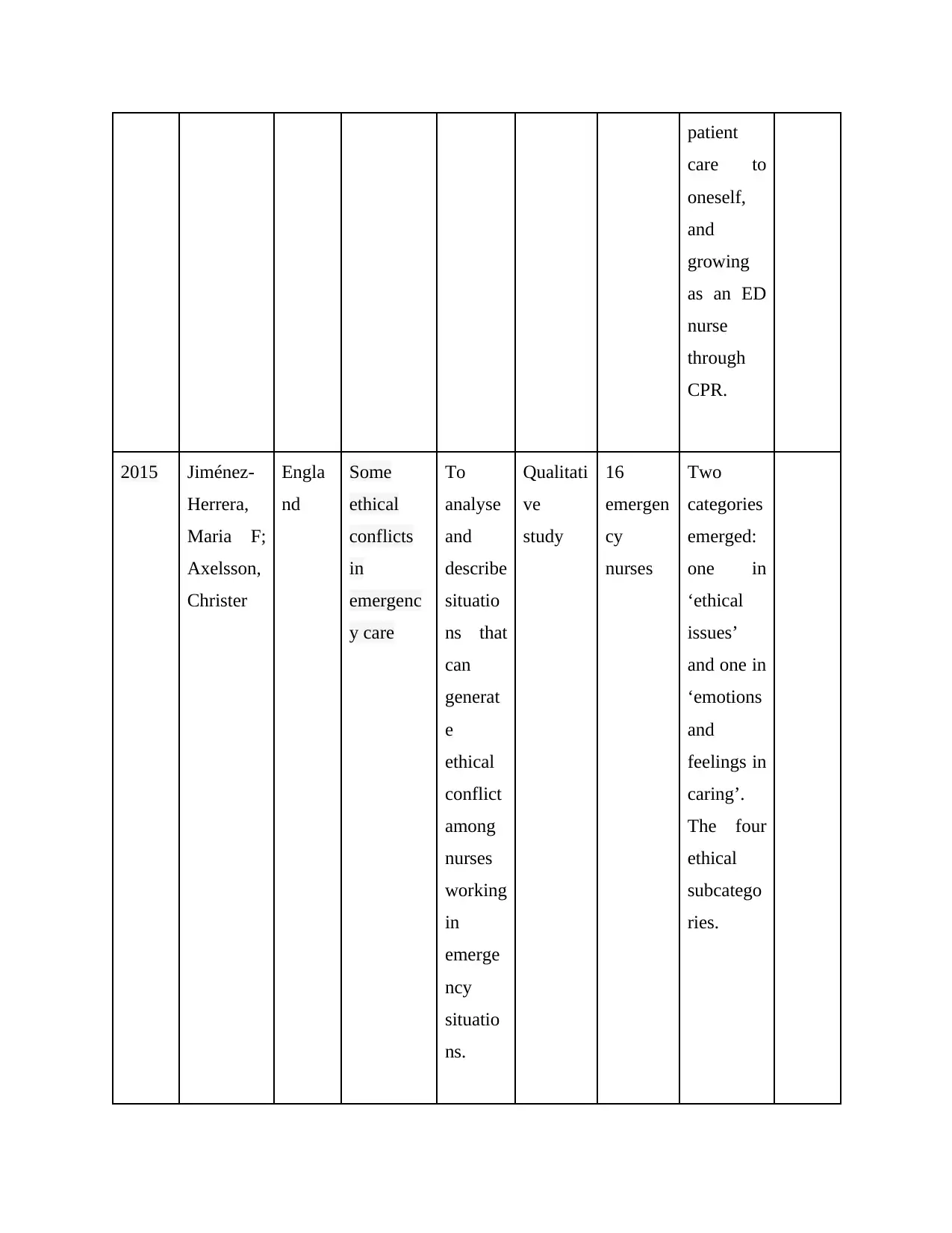
patient
care to
oneself,
and
growing
as an ED
nurse
through
CPR.
2015 Jiménez-
Herrera,
Maria F;
Axelsson,
Christer
Engla
nd
Some
ethical
conflicts
in
emergenc
y care
To
analyse
and
describe
situatio
ns that
can
generat
e
ethical
conflict
among
nurses
working
in
emerge
ncy
situatio
ns.
Qualitati
ve
study
16
emergen
cy
nurses
Two
categories
emerged:
one in
‘ethical
issues’
and one in
‘emotions
and
feelings in
caring’.
The four
ethical
subcatego
ries.
care to
oneself,
and
growing
as an ED
nurse
through
CPR.
2015 Jiménez-
Herrera,
Maria F;
Axelsson,
Christer
Engla
nd
Some
ethical
conflicts
in
emergenc
y care
To
analyse
and
describe
situatio
ns that
can
generat
e
ethical
conflict
among
nurses
working
in
emerge
ncy
situatio
ns.
Qualitati
ve
study
16
emergen
cy
nurses
Two
categories
emerged:
one in
‘ethical
issues’
and one in
‘emotions
and
feelings in
caring’.
The four
ethical
subcatego
ries.
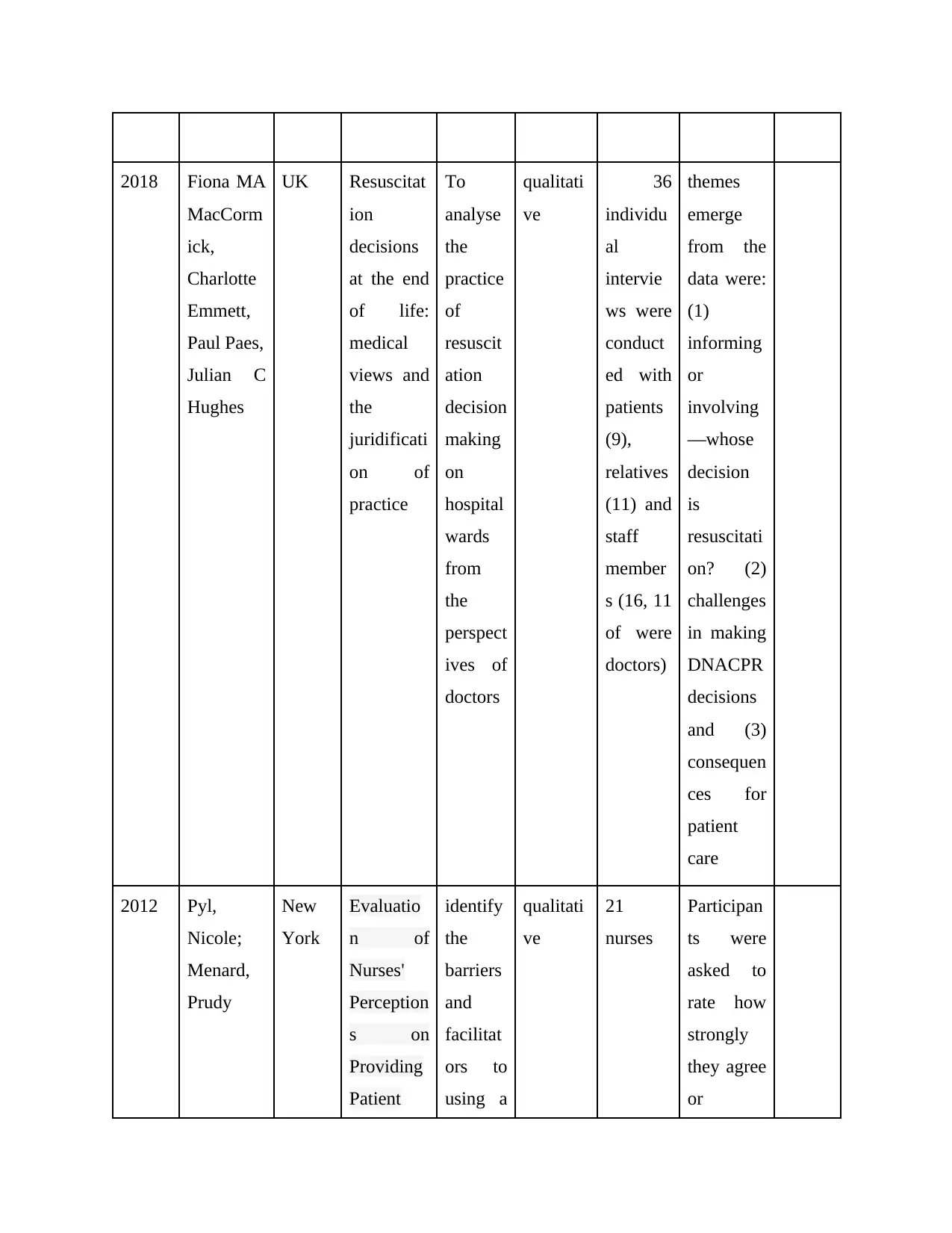
2018 Fiona MA
MacCorm
ick,
Charlotte
Emmett,
Paul Paes,
Julian C
Hughes
UK Resuscitat
ion
decisions
at the end
of life:
medical
views and
the
juridificati
on of
practice
To
analyse
the
practice
of
resuscit
ation
decision
making
on
hospital
wards
from
the
perspect
ives of
doctors
qualitati
ve
36
individu
al
intervie
ws were
conduct
ed with
patients
(9),
relatives
(11) and
staff
member
s (16, 11
of were
doctors)
themes
emerge
from the
data were:
(1)
informing
or
involving
—whose
decision
is
resuscitati
on? (2)
challenges
in making
DNACPR
decisions
and (3)
consequen
ces for
patient
care
2012 Pyl,
Nicole;
Menard,
Prudy
New
York
Evaluatio
n of
Nurses'
Perception
s on
Providing
Patient
identify
the
barriers
and
facilitat
ors to
using a
qualitati
ve
21
nurses
Participan
ts were
asked to
rate how
strongly
they agree
or
MacCorm
ick,
Charlotte
Emmett,
Paul Paes,
Julian C
Hughes
UK Resuscitat
ion
decisions
at the end
of life:
medical
views and
the
juridificati
on of
practice
To
analyse
the
practice
of
resuscit
ation
decision
making
on
hospital
wards
from
the
perspect
ives of
doctors
qualitati
ve
36
individu
al
intervie
ws were
conduct
ed with
patients
(9),
relatives
(11) and
staff
member
s (16, 11
of were
doctors)
themes
emerge
from the
data were:
(1)
informing
or
involving
—whose
decision
is
resuscitati
on? (2)
challenges
in making
DNACPR
decisions
and (3)
consequen
ces for
patient
care
2012 Pyl,
Nicole;
Menard,
Prudy
New
York
Evaluatio
n of
Nurses'
Perception
s on
Providing
Patient
identify
the
barriers
and
facilitat
ors to
using a
qualitati
ve
21
nurses
Participan
ts were
asked to
rate how
strongly
they agree
or
Secure Best Marks with AI Grader
Need help grading? Try our AI Grader for instant feedback on your assignments.
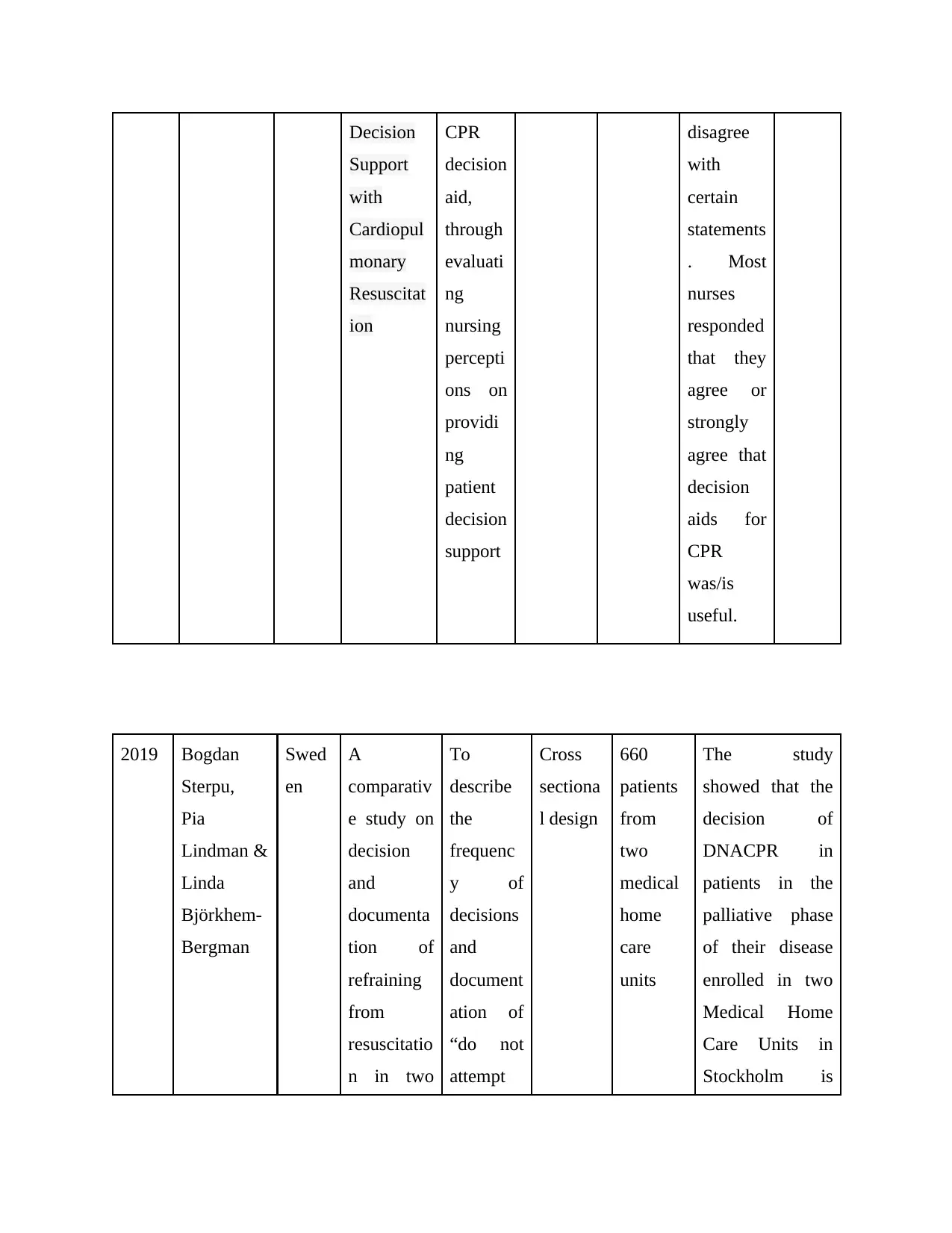
Decision
Support
with
Cardiopul
monary
Resuscitat
ion
CPR
decision
aid,
through
evaluati
ng
nursing
percepti
ons on
providi
ng
patient
decision
support
disagree
with
certain
statements
. Most
nurses
responded
that they
agree or
strongly
agree that
decision
aids for
CPR
was/is
useful.
2019 Bogdan
Sterpu,
Pia
Lindman &
Linda
Björkhem-
Bergman
Swed
en
A
comparativ
e study on
decision
and
documenta
tion of
refraining
from
resuscitatio
n in two
To
describe
the
frequenc
y of
decisions
and
document
ation of
“do not
attempt
Cross
sectiona
l design
660
patients
from
two
medical
home
care
units
The study
showed that the
decision of
DNACPR in
patients in the
palliative phase
of their disease
enrolled in two
Medical Home
Care Units in
Stockholm is
Support
with
Cardiopul
monary
Resuscitat
ion
CPR
decision
aid,
through
evaluati
ng
nursing
percepti
ons on
providi
ng
patient
decision
support
disagree
with
certain
statements
. Most
nurses
responded
that they
agree or
strongly
agree that
decision
aids for
CPR
was/is
useful.
2019 Bogdan
Sterpu,
Pia
Lindman &
Linda
Björkhem-
Bergman
Swed
en
A
comparativ
e study on
decision
and
documenta
tion of
refraining
from
resuscitatio
n in two
To
describe
the
frequenc
y of
decisions
and
document
ation of
“do not
attempt
Cross
sectiona
l design
660
patients
from
two
medical
home
care
units
The study
showed that the
decision of
DNACPR in
patients in the
palliative phase
of their disease
enrolled in two
Medical Home
Care Units in
Stockholm is

medical
home care
units in
Sweden
cardiopul
monary
resuscitat
ion”
(DNACP
R) in two
Medical
Home
Care
Units in
Stockhol
m
documented in
less than 50% of
cases. Written
guidelines about
DNACPR-
documentation
and the
requirement for a
CPR-decision
did not increase
the frequency of
DNACPR
decision taking.
home care
units in
Sweden
cardiopul
monary
resuscitat
ion”
(DNACP
R) in two
Medical
Home
Care
Units in
Stockhol
m
documented in
less than 50% of
cases. Written
guidelines about
DNACPR-
documentation
and the
requirement for a
CPR-decision
did not increase
the frequency of
DNACPR
decision taking.
1 out of 18
Related Documents
Your All-in-One AI-Powered Toolkit for Academic Success.
+13062052269
info@desklib.com
Available 24*7 on WhatsApp / Email
![[object Object]](/_next/static/media/star-bottom.7253800d.svg)
Unlock your academic potential
© 2024 | Zucol Services PVT LTD | All rights reserved.




